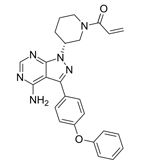ASH: Ibrutinib for Chronic Lymphocytic Leukemia Exhibits Durable Responses
The targeted agent ibrutinib has shown a high response rate in both treatment-naive and previously treated, relapsed, refractory chronic lymphocytic leukemia (CLL) patients older than 65.
The targeted agent ibrutinib has shown a relatively high response rate in both treatment-naive and previously treated, relapsed, refractory chronic lymphocytic leukemia (CLL) patients who were older than 65. The results of the 116-patient phase Ib/II trial were presented at the annual American Society of Hematology (ASH) meeting in Atlanta.

Chemical structure of ibrutinib
Treatment-naive CLL patients had a 68% overall response rate, including 10% complete response, on ibrutinib monotherapy. The estimated progression-free survival rate for the 31 patients in this cohort was 96% at 22 months. Relapsed, refractory patients had a 71% overall response rate. A high-risk cohort of 24 patients had a 50% response rate. High-risk was defined as either a 17p deletion or relapse within 2 years following combination chemoimmunotherapy. The combined progression-free survival rate for the relapsed, refractory, and high-risk patients was 76%. The median progression-free survival and overall survival has not yet been met for any of the patient cohorts.
Older CLL patients are considered a critical unmet need. These patients have few treatment options, as patients cannot tolerate most therapy regimens for long, resulting in very few durable responses. “The therapies particularly for older patients with CLL are unacceptable and not good due to low response, short remission, and significant toxicity, particularly with chemotherapy,” said John C. Byrd, MD, director of the division of hematology at the Ohio State University Comprehensive Cancer Center, who presented of the data at a press conference. “Historic therapies do not work well for high-risk groups,” Byrd told Cancer Network.
“Ibrutinib offers great potential to change the treatment landscape in CLL,” said Dr. Byrd at a press conference.
The trial tested the safety, tolerability, and efficacy of two doses of ibrutinib, 420 mg and 840 mg per day. The majority of adverse events were of low grade, including diarrhea (54%), fatigue (29%), upper respiratory tract infection (29%), rash (28%), nausea (26%), and arthralgias (25%). Cytopenia was also low, less than 25% in the relapsed patient cohort and less than 10% in treatment-naive patients. This is in contrast to the 70% to 80% rate of cytopenias seen with standard therapies, according to the study authors.
No long-term safety concerns or accumulating toxicities were found following a median of 16 months of follow up. Seven of the 116 patients discontinued treatment in the trial. High-grade toxicities included infections in the refractory patients, but at lower frequencies than seen with standard chemotherapy therapy. The side effects of ibrutinib are very tolerable, according to the study researchers, which results in longer patient treatment and better outcomes.
“Unlike many other drugs that have been used in CLL, where myelosuppression and immunosuppression are problematic, this was not a common toxicity seen with [ibrutinib] and in fact, most of the side effects were grade 1 or 2 and often went away after the first couple of cycles of oral therapy,” said Byrd at a press conference.
Ibrutinib is an oral drug that selectively targets leukemia cells by inhibiting the Burton tyrosine kinase (BTK), an enzyme important in the pathways that are activated in CLL-the first drug that targets BTK. BTK is expressed in the majority of blood cells, but not in T cells. It is thought that ibrutinib works by silencing critical pathways that are necessary for CLL and promotes cell death in these cancer cells. The drug, formerly known as PCI-32765 is being developed by California-based Pharmacyclics.
Initial results from this trial in treatment-naive, older patients were first presented in June at this year’s American Society of Clinical Oncology (ASCO) meeting.
CLL is the most common type of leukemia in adults. CLL results in the accumulation of white blood cells that are abnormal in the bone marrow, blubood, and the lymph nodes. About 16,000 people in the United States are diagnosed annually with CLL, the vast majority of which are older than 65 years of age. Approximately 4,500 patients die of their disease each year. CLL can either be a slowly progressing disease or a rapidly progressing one that requires timely treatment.
Another trial combining rituximab in 40 high-risk CLL, presented at this year’s ASH shows the combination is both well tolerated and has activity.
Ibrutinib results in combination with rituximab and bendamustine in relapsed, refractory non-Hodgkin lymphoma, in de novo diffuse large B-cell lymphoma, and relapsed or refractory mantle cell lymphoma are also being presented at the ASH meeting.
Future trials will likely test ibrutinib as both a monotherapy and in combination, according to Byrd. “It is likely that it will be tested in both ways although it may be possible that monotherapy is acceptable for many patients with CLL. The phase III trials will tell us the answer.”
“It is an exciting time right now for CLL therapy with all of the new active drugs,” said Byrd.
Navigating AE Management for Cellular Therapy Across Hematologic Cancers
A panel of clinical pharmacists discussed strategies for mitigating toxicities across different multiple myeloma, lymphoma, and leukemia populations.